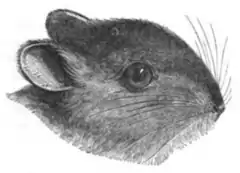| Reithrodon | |||
| Waterhouse, 1837[1] | |||
 Przedstawiciel rodzaju – głowa bruzdówki uszatej (R. auritus) | |||
| Systematyka | |||
| Domena | |||
|---|---|---|---|
| Królestwo | |||
| Typ | |||
| Podtyp | |||
| Gromada | |||
| Podgromada | |||
| Infragromada | |||
| Rząd | |||
| Podrząd | |||
| Infrarząd | |||
| Nadrodzina | |||
| Rodzina | |||
| Podrodzina | |||
| Plemię | |||
| Rodzaj |
bruzdówka | ||
| Typ nomenklatoryczny | |||
|
Reithrodon typicus Waterhouse, 1837 | |||
| Synonimy | |||
|
| |||
| Gatunki | |||
| |||
Bruzdówka[9] (Reithrodon) – rodzaj ssaków z podrodziny bawełniaków (Sigmodontinae) w obrębie rodziny chomikowatych (Cricetidae).
Zasięg występowania
Rodzaj obejmuje gatunki występujące w Ameryce Południowej[10][11][12].
Morfologia
Długość ciała (bez ogona) 126–150 mm, długość ogona 79–120 mm, długość ucha 22–28 mm, długość tylnej stopy 27–35 mm; masa ciała 52–105 g[11][13].
Systematyka
Rodzaj zdefiniował w 1837 roku angielski przyrodnik George Robert Waterhouse na łamach Proceedings of the Zoological Society of London[1]. Na gatunek typowy Waterhouse wyznaczył (oryginalne oznaczenie) bruzdówkę nagostopą (R. typicus).
Etymologia
- Reithrodon (Rithrodon, Rheithrodon, Rheitrodon, Rhithrodon): gr. ρειθρον reithon ‘kanał, bruzda’; οδους odous, οδοντος odontos ‘ząb’[14].
- Ptyssophorus: gr. πτυσσω ptussō ‘zwijać’; -φορος -phoros ‘-dźwigać’, od φερω pherō ‘nosić’[15]. Gatunek typowy: Ptyssophorus elegans Ameghino, 1899 (= Mus auritus G. Fischer, 1814).
- Tretomys: gr. τρητος trētos ‘perforowany’; μυς mus, μυoς muos ‘mysz’[16]. Gatunek typowy: Tretomys atavus Ameghino, 1899 (= Mus auritus G. Fischer, 1814).
- Proreithrodon: gr. προ pro ‘blisko, w pobliżu’[17]; rodzaj Reithrodon Waterhouse, 1837. Gatunek typowy: Proreithrodon chapalmalense Ameghino, 1908 (= Mus auritus G. Fischer, 1814).
Podział systematyczny
Do rodzaju należą następujące gatunki[18][13][10][9]:
- Reithrodon caurinus O. Thomas, 1920
- Reithrodon typicus Waterhouse, 1837 – bruzdówka nagostopa
- Reithrodon auritus (G. Fischer, 1814) – bruzdówka uszata
Uwagi
Przypisy
- 1 2 G.R. Waterhouse. Hitherto undescribed, and drawings were exhibited by him illustrative of the modifications observable in their dentition. „Proceedings of the Zoological Society of London”. 5 (1), s. 29, 1837. (ang.).
- ↑ Index universalis. W: L. Agassiz: Nomenclator zoologicus, continens nomina systematica generum animalium tam viventium quam fossilium, secundum ordinem alphabeticum disposita, adjectis auctoribus, libris, in quibus reperiuntur, anno editionis, etymologia et familiis, ad quas pertinent, in singulis classibus. Soloduri: Jent et Gassmann, 1842–1846, s. 327. (łac.).
- ↑ O. Thomas. On a collection of Muridœ from central Peru. „Proceedings of the Zoological Society of London”. 1844 (3), s. 457, 1884. (ang.).
- ↑ O. Roger. Verzeichniss der bisher bekannten fossilen Säugethiere. „Bericht des Naturwissenschaftlichen Vereins für Schwaben und Neuburg (a. V.)”. 29, s. 102, 1887. (niem.).
- ↑ W.H. Flower & R. Lydekker: An introduction to the study of mammals living and extinct. London: A. and C. Black, 1891, s. 464. (ang.).
- ↑ Ameghino 1899 ↓, s. 111.
- ↑ Ameghino 1899 ↓, s. 119.
- ↑ F. Ameghino. Las formaciones sedimentarias de la región litoral de Mar del Plata y Chapalmalán. „Anales del Museo Nacional de Buenos Aires”. Serie III. 10, s. 424, 1908. (hiszp.).
- 1 2 Nazwy polskie za: W. Cichocki, A. Ważna, J. Cichocki, E. Rajska-Jurgiel, A. Jasiński & W. Bogdanowicz: Polskie nazewnictwo ssaków świata. Warszawa: Muzeum i Instytut Zoologii PAN, 2015, s. 254. ISBN 978-83-88147-15-9. (pol. • ang.).
- 1 2 C.J. Burgin, D.E. Wilson, R.A. Mittermeier, A.B. Rylands, T.E. Lacher & W. Sechrest: Illustrated Checklist of the Mammals of the World. Cz. 1: Monotremata to Rodentia. Barcelona: Lynx Edicions, 2020, s. 392. ISBN 978-84-16728-34-3. (ang.).
- 1 2 U. Pardiñas, P. Myers, L. León-Paniagua, N.O. Garza, J. Cook, B. Kryštufek, R. Haslauer, R. Bradley, G. Shenbrot & J. Patton. Opisy gatunków Cricetidae: U. Pardiñas, D. Ruelas, J. Brito, L. Bradley, R. Bradley, N.O. Garza, B. Kryštufek, J. Cook, E.C. Soto, J. Salazar-Bravo, G. Shenbrot, E. Chiquito, A. Percequillo, J. Prado, R. Haslauer, J. Patton & L. León-Paniagua: Family Cricetidae (True Hamsters, Voles, Lemmings and New World Rats and Mice). W: D.E. Wilson, R.A. Mittermeier & T.E. Lacher (redaktorzy): Handbook of the Mammals of the World. Cz. 7: Rodents II. Barcelona: Lynx Edicions, 2017, s. 412–413. ISBN 978-84-16728-04-6. (ang.).
- ↑ D.E. Wilson & D.M. Reeder (redaktorzy): Genus Reithrodon. [w:] Mammal Species of the World. A Taxonomic and Geographic Reference (Wyd. 3) [on-line]. Johns Hopkins University Press, 2005. [dostęp 2020-11-30].
- 1 2 Class Mammalia. W: Lynx Nature Books: All the Mammals of the World. Barcelona: Lynx Edicions, 2023, s. 249. ISBN 978-84-16728-66-4. (ang.).
- ↑ Palmer 1904 ↓, s. 602.
- ↑ Palmer 1904 ↓, s. 597.
- ↑ Palmer 1904 ↓, s. 686.
- ↑ Edmund C. Jaeger, Source-book of biological names and terms, wyd. 1, Springfield: Charles C. Thomas, 1944, s. 184, OCLC 637083062 (ang.).
- ↑ N. Upham, C. Burgin, J. Widness, M. Becker, C. Parker, S. Liphardt, I. Rochon & D. Huckaby: Treeview of Mammalian Taxonomy Hierarchy. [w:] ASM Mammal Diversity Database (Version 1.11) [on-line]. American Society of Mammalogists. [dostęp 2023-10-06]. (ang.).
Bibliografia
- F. Ameghino: Contribucion al conocimiento de los mamiferos fosiles de la República Argentina. Obra escrita bajo los auspicios de la Academia nacional de ciencias de la República Argentina para ser presentada á la Exposicion universal de Paris de 1889. Buenos Aires: Impr. de P.E. Coni é hijo, 1899, s. 1–989, seria: Actas de la Academia nacional de ciencias de la República Argentina en Cordoba. Tom 6. (hiszp.).
- T.S. Palmer. Index Generum Mammalium: a List of the Genera and Families of Mammals. „North American Fauna”. 23, s. 1–984, 1904. (ang.).
This article is issued from Wikipedia. The text is licensed under Creative Commons - Attribution - Sharealike. Additional terms may apply for the media files.